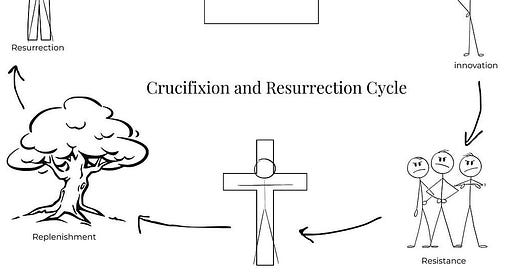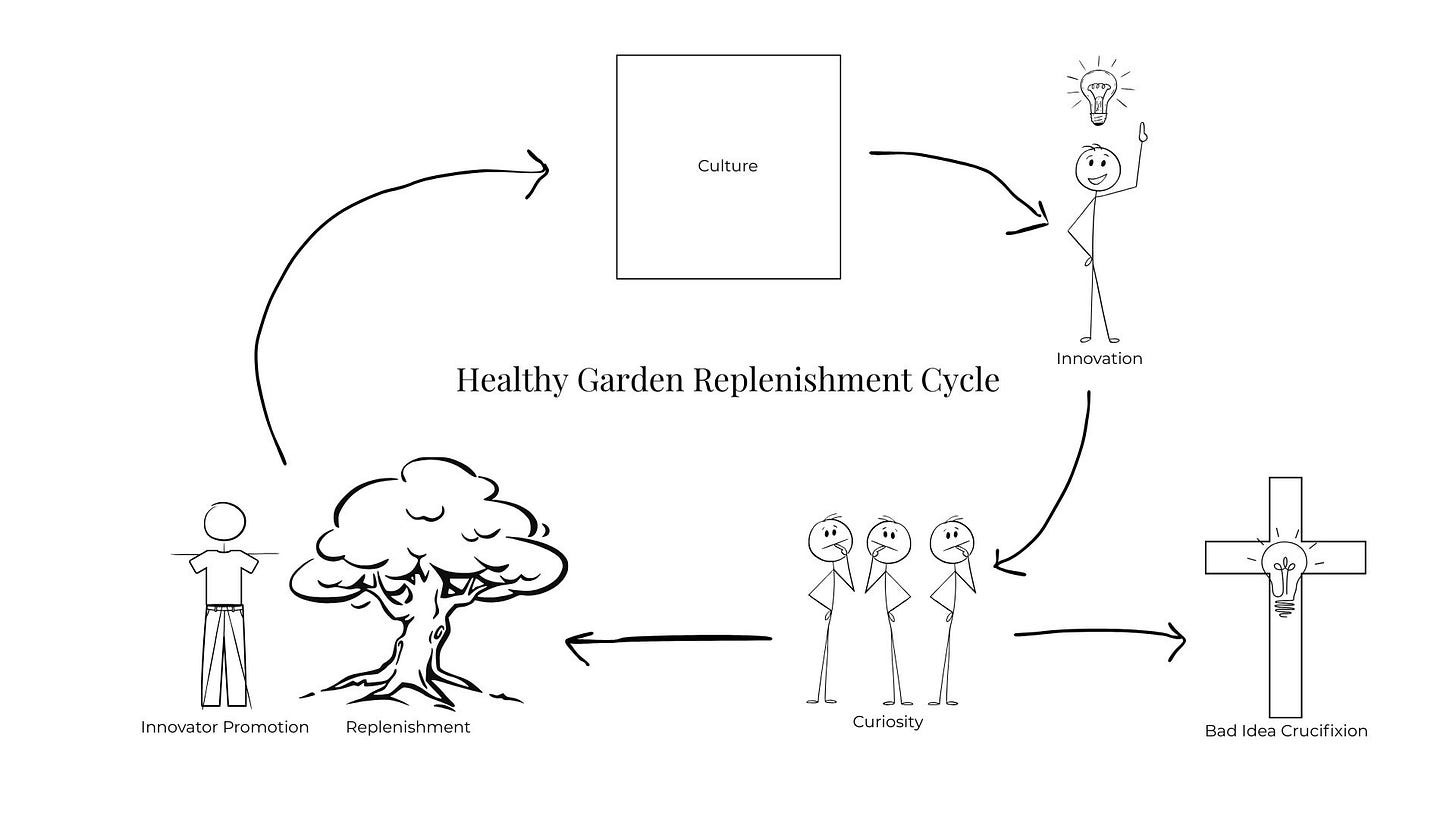The story of the crucifixion and resurrection of Jesus can be viewed as a model of human behaviour in an unhealthy garden.
Its pattern is such that:
Change is a constant but people resist change, so the innovators of change are often crucified. But, if the innovation adds value, eventually it along with its creator shall be resurrected.
Let's look at the steps in the story of Jesus leading up to his crucifixion:
People followed the Law of Moses (including the 10 commandments)
Jesus introduced some changes (e.g., if someone needs to work on Sabbath, let him and stop stoning people for their sins)
The leaders of the garden didn't want that change as it attacked their positions of power and authority
Jesus is crucified on the cross
Time passes (3 days)
Jesus is resurrected and dressed in fresh white garments
What does this look like if it is observed as a universal pattern?
The Culture of the garden is the status quo, "the way we do things around here," "this is tradition," "this is the law"
Innovation is introduced
Resistance (can come from the top or bottom)
Innovator and innovation is crucified
Time passes where things in the garden get worse without the innovation and better when the innovation is implemented
Garden is replenished through innovation
Innovator is resurrected
This pattern can be observed across time and history in every culture, religion, society and even family home – anything that runs as an organisation. Let's look at two examples.
Case study of Nelson Mandela
Culture in the garden: Blacks and whites must be segregated in a system known as apartheid
Innovation: Let us live together in peace and in harmony without any discrimination laws
Resistance: White leaders felt their power threatened
Crucifixion: Nelson Mandela is imprisoned
Time passes: 27 years where things got worse and pressure is applied
Replenishment: Apartheid ends and blacks and whites unite
Resurrection: Mandela becomes president
Case study of Dr. Ignaz Semmelweis
Culture in the garden: Childbed fever deaths are God's punishment on the women
Innovation: Actually, they are caused by a lack of hygiene practices from the doctors
Resistance: How dare you accuse us doctors? We are the elite
Crucifixion: Semmelweis is sent to a mental institution where he dies
Time passes: 5 years later bacteria is discovered and hygiene practices are implemented
Replenishment: Childbed fever ends and healthy children are born
Resurrection: Semmelweis is vindicated
In all three scenarios, the crucifixion is ordered by those at the top—the leaders of the garden. Is this always the case?
Well, it is common because it threatens their position of authority. As the snake said, "Ye shall be as gods." In other words, you will make him redundant. You will take their position. For the leader who seeks to serve himself rather than his people, who is unsure about what else he might do in the garden if his position is removed, who has too much pride, he will not want to step down and learn something new. He will not want to be replaced, or to adjust his ways. He would rather allow the garden to turn into hell and have the people of the kingdom suffer than to admit that change is simply a constant.
However, resistance does not always come from those at the top. There would have been Jews who enjoyed stoning women, and white South Africans who enjoyed the feeling of superiority to their black counterparts. These were not leaders in the garden, but they resisted the change because they gained a sense of moral superiority in the current status quo.
Thomas Sowell put it best:
It is usually futile to try to talk facts and analysis to people who are enjoying a sense of moral superiority in their ignorance.
So now, we must ask ourselves:
Is this pattern set in stone?
Will innovators of change always be crucified?
Will replenishment always take so long to occur?
It depends. It depends on three factors:
Openness—to what degree are people open to listen to dissenting ideas?
Truth—to what degree are people willing to align themselves with truth as it reveals itself?
Love—to what degree are people willing to crucify an idea rather than the person?
1 - Openness: To what degree are people open-minded and willing to listen to a dissenting opinion?
The more open a society is to change, the less resistance there will be. If the people of the garden are agents of change and embrace an innovative culture, seeking to make things better based on truth and empirical data then they will listen to new ideas.
Jesus put the idea of openness like this:
Nothing outside a person can defile them by going into them. Rather, it is what comes out of a person that defiles them.
Mark 7:15 [NIV]
Remember that Eve embraced conversing with the snake. The blockage of openness is ignorance.
2 – Truth: To what degree are people willing to align themselves with truth as it reveals itself?
Even if truth reveals itself, many will not want to change or adapt because perhaps they have attached their identity to the status quo.
For example, the doctors, being experts in the field, would rather have more women die from childbed fever than to admit that it was something they did not know.
Remember that Eve consumed the fruit because it would make her wise. The blockage of truth is ego.
3 – Love: To what degree are people willing to crucify an idea as opposed to the person?
There is a difference between the person and their idea. People get things wrong. If the innovation does not work then it should be binned, but this does not mean that their livelihood needs to be annexed. You do not shut down the person—this is where a culture of love and forgiveness is necessary, so that ideas are freely had and debated in the battle of ideas. You will not be crucified—but the idea will.
Remember that the snake existed in the garden. The blockage to love is hatred.
All three factors of openness, truth and love are necessary ingredients for a culture of continual change and replenishment, and all three factors are present in the following quote:
The peculiar evil of silencing the expression of an opinion is, that it is robbing the human race; posterity as well as the existing generation; those who dissent from the opinion still more than those who hold it. If the opinion is right, they are deprived of the opportunity of exchanging error for truth: if wrong, they lose, what is almost as great a benefit, the clearer perception and livelier impression of truth, produced by its collision with error.
J.S. Mill, On Liberty, 1859
If all three factors are implemented then the crucifixion and resurrection cycle will transform into the "Healthy Garden Replenishment Cycle" which looks like this:
Culture: There is an established status quo
Innovation: Someone has an idea to make an improvement upon current processes
Curiosity: The leaders and people of the garden listen to the idea
Bad Idea Crucifixion: If the idea does not create life it is crucified
Replenishment: Only the truthful idea will create more life in the garden
Innovator Promotion: He or she who contributed the innovation is promoted in society
In a healthy garden, replenishment is much quicker.
A Call to Action
The crucifixion and resurrection model is an example of an unhealthy garden. Jesus should not have been crucified for adding value to the garden. The healthier garden embraces change and improvement based on truth. The good thing is that we now have the opportunity to become agents of change in our personal lives, organizations and communities by embracing the following characteristics:
Cultivate openness in your spheres of influence. Create spaces where innovative ideas can be shared without fear of personal attack. Ask yourself: "How might I be resistant to change in my own life?"
Pursue truth relentlessly, even when it challenges your deepest assumptions. Evaluate ideas on their merits rather than their source or how they make you feel. Remember that truth often arrives in uncomfortable packages.
Practice love in disagreement by separating ideas from the people who hold them. Critique concepts vigorously while preserving the dignity of those you disagree with. Be willing to crucify bad ideas without crucifying the person.
The cycle of crucifixion and resurrection is the unnecessary and longer version of the healthy garden’s replenishment cycle. Change is a constant so the question isn't whether change will come—it's whether we'll be agents of crucifixion or agents of change.





